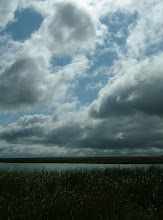






 The flowering plants of the prairie, the ‘forbs’ as we call them, provide the brilliant summer colors that catch our eye. They, not the grasses, are the first to capture our attention and make us wonder what is growing out there. The flowers provide the nectar and pollen for bees, of which there are hundreds of species. These prairie bees are solitary bees, living alone and laying eggs one at a time in holes in woody plant stalks, then packing the hole full of food for the larva. The flowering plants provide nectar for hummingbirds and many kinds of insects. Predatory insects such a spiders and beetle larva live on them to capture the flying insects. Sucking insects of many kinds live on the plant juices. Leaf eating insects and animals rely on their foliage that is softer and more digestible than that of the tough grasses. The flowering plants host hundreds of species of insects and birds and mammals and reptiles and amphibians. The summer flowers with their nectar and pollen mature into seeds that feed the birds and animals on into winter. These seeds might be tiny and air born like those of the asters or larger snacks such as those found in the heads of compass plant and prairie dock. The plant stems and leaves harbor eggs of next year’s insects and hold the nests of small songbirds. That is just the life above the soil line, for much remains to be learned about the life below ground that feeds on the roots and carries out entire life cycles or maybe just parts of them down there among the roots. And those roots go deep. The roots of the forbs are thicker, much deeper counterparts to the fine sponge of the grass roots. Studies in unplowed prairies found roots dozens of feet below the ground, where they break up soil and guide rain water drainage to deeper layers to allow aquifer recharge. Someday, we might be smart enough to use the sponge layer of grass roots and the drainhole producing layer of forbs roots to manage the storm water of our urban and suburban areas instead of our ugly resource consuming high-tech curbs and gutters and storm sewer systems. For now, we can preserve and restore prairies where we can, and we can grow these plants in our own home gardens to enjoy their beauty and maybe attract some of the life that they so abundantly support.
The flowering plants of the prairie, the ‘forbs’ as we call them, provide the brilliant summer colors that catch our eye. They, not the grasses, are the first to capture our attention and make us wonder what is growing out there. The flowers provide the nectar and pollen for bees, of which there are hundreds of species. These prairie bees are solitary bees, living alone and laying eggs one at a time in holes in woody plant stalks, then packing the hole full of food for the larva. The flowering plants provide nectar for hummingbirds and many kinds of insects. Predatory insects such a spiders and beetle larva live on them to capture the flying insects. Sucking insects of many kinds live on the plant juices. Leaf eating insects and animals rely on their foliage that is softer and more digestible than that of the tough grasses. The flowering plants host hundreds of species of insects and birds and mammals and reptiles and amphibians. The summer flowers with their nectar and pollen mature into seeds that feed the birds and animals on into winter. These seeds might be tiny and air born like those of the asters or larger snacks such as those found in the heads of compass plant and prairie dock. The plant stems and leaves harbor eggs of next year’s insects and hold the nests of small songbirds. That is just the life above the soil line, for much remains to be learned about the life below ground that feeds on the roots and carries out entire life cycles or maybe just parts of them down there among the roots. And those roots go deep. The roots of the forbs are thicker, much deeper counterparts to the fine sponge of the grass roots. Studies in unplowed prairies found roots dozens of feet below the ground, where they break up soil and guide rain water drainage to deeper layers to allow aquifer recharge. Someday, we might be smart enough to use the sponge layer of grass roots and the drainhole producing layer of forbs roots to manage the storm water of our urban and suburban areas instead of our ugly resource consuming high-tech curbs and gutters and storm sewer systems. For now, we can preserve and restore prairies where we can, and we can grow these plants in our own home gardens to enjoy their beauty and maybe attract some of the life that they so abundantly support.
No comments:
Post a Comment